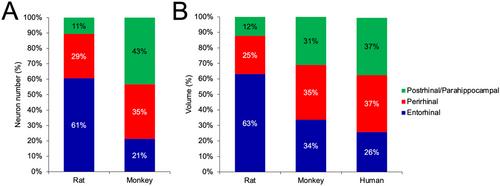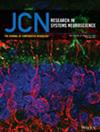Stereological Analysis of the Rhesus Monkey Perirhinal and Parahippocampal Cortices
Abstract
The perirhinal and parahippocampal cortices are key components of the medial temporal lobe memory system. Despite their essential roles in mnemonic and perceptual functions, there is limited quantitative information regarding their structural characteristics. Here, we implemented design-based stereological techniques to provide estimates of neuron number, neuronal soma size, and volume of the different layers and subdivisions of the perirhinal and parahippocampal cortices in adult macaque monkeys (Macaca mulatta, 5–9 years of age). We found that areas 36r and 36c of the perirhinal cortex and areas TF and TH of the parahippocampal cortex exhibit relatively large superficial layers, which are characteristic of the laminar organization of higher order associational cortices. In contrast, area 35 of the perirhinal cortex exhibits relatively large deep layers. Although neuronal soma size varies between subdivisions and layers, neurons are generally larger in the perirhinal cortex than in the parahippocampal cortex and even larger in the entorhinal cortex. These morphological characteristics are consistent with the hierarchical organization of these cortices within the medial temporal lobe. Comparing data in rats, monkeys, and humans, we found species differences in the relative size of these structures, showing that the perirhinal and parahippocampal cortices have expanded in parallel to the cerebral cortex and may play a greater role in the integration of information in the neocortical–hippocampal loop in primates. Altogether, these normative data provide an essential reference to extrapolate findings from experimental studies in animals and create realistic models of the medial temporal lobe memory system.


 求助内容:
求助内容: 应助结果提醒方式:
应助结果提醒方式:


